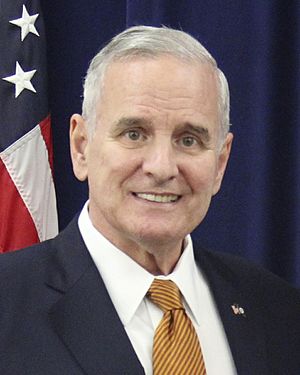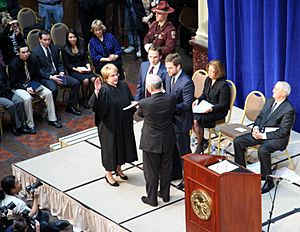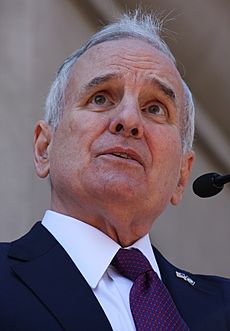Mark Dayton facts for kids
Quick facts for kids
Mark Dayton
|
|
|---|---|

Dayton in 2016
|
|
| 40th Governor of Minnesota | |
| In office January 3, 2011 – January 7, 2019 |
|
| Lieutenant | Yvonne Prettner Solon (2011–2015) Tina Smith (2015–2018) Michelle Fischbach (2018–2019) |
| Preceded by | Tim Pawlenty |
| Succeeded by | Tim Walz |
| United States Senator from Minnesota |
|
| In office January 3, 2001 – January 3, 2007 |
|
| Preceded by | Rod Grams |
| Succeeded by | Amy Klobuchar |
| 15th Auditor of Minnesota | |
| In office January 7, 1991 – January 3, 1995 |
|
| Governor | Arne Carlson |
| Preceded by | Arne Carlson |
| Succeeded by | Judi Dutcher |
| Personal details | |
| Born |
Mark Brandt Dayton
January 26, 1947 Minneapolis, Minnesota, U.S. |
| Political party | Democratic |
| Spouses |
Alida Rockefeller
(m. 1978; div. 1986)Janice Haarstick
(m. 1996; div. 1999)Ana Orke
(m. 2020) |
| Children | 2 |
| Relatives | Bruce Dayton (father) George Dayton (great-grandfather) |
| Education | Yale University (BA) |
Mark Brandt Dayton (born January 26, 1947) is an American politician. He served as the 40th governor of Minnesota. His term was from 2011 to 2019.
Before becoming governor, he was a U.S. Senator for Minnesota. He held that role from 2001 to 2007. He also served as the Minnesota State Auditor from 1991 to 1995. Dayton is a member of the Minnesota Democratic–Farmer–Labor Party (DFL). This party is linked to the national Democratic Party.
Mark Dayton grew up in Minnesota. His great-grandfather, George Dayton, started the Dayton's department store. This store later became the Target Corporation. After college, Mark Dayton worked as a teacher and in social work. He lived in New York City and Boston. In the 1970s, he worked for U.S. Senator Walter Mondale. He also worked for Minnesota Governor Rudy Perpich. In 1978, he became Minnesota's Economic Development Commissioner.
Dayton ran for the U.S. Senate in 1982. He lost that election. In 2000, he won a U.S. Senate seat. He defeated the Republican, Rod Grams. As a senator, he voted against the Iraq War. He also suggested creating a new government department for peace. In 2006, he decided not to run again. He said he was tired of politics in Washington, D.C..
In 2010, Dayton became governor of Minnesota. He won against Tom Emmer. He won a second term in 2014. During his time as governor, same-sex marriage became legal in Minnesota. He also helped build U.S. Bank Stadium.
Contents
Early Life and Education
Mark Dayton was born on January 26, 1947. His birthplace was Minneapolis, Minnesota. He is the oldest of four children. His father, Bruce Dayton, was a leader at the company that became Target Corporation. His great-grandfather, George Dayton, founded the famous Dayton's stores.
Mark grew up in Long Lake, Minnesota. He went to the Blake School. He was a great ice hockey goalie there.
Dayton then attended Yale University. He played hockey until an injury. He earned a degree in psychology in 1969. After college, he taught in New York City. He also worked for a social service group in Boston.
Start of Political Career
Dayton became involved in politics in the 1960s. He protested the Vietnam War.
From 1975 to 1976, he worked for Senator Walter Mondale. Mondale later became Vice President of the United States. From 1977 to 1978, Dayton worked for Minnesota Governor Rudy Perpich. Governor Perpich then made him head of the Department of Economic Development.
In 1990, Dayton was elected Minnesota State Auditor. He served in this role until 1995.
Time as U.S. Senator

Dayton first ran for the United States Senate in 1982. He lost to David Durenberger. This election was one of the most expensive in Minnesota's history. Dayton promised to "close tax loopholes for the rich."
He won his Senate election in 2000. He defeated Rod Grams. Dayton used $12 million of his own money for this campaign.
What He Did as Senator
While in the Senate, Dayton gave his salary away. He used it to pay for bus trips for seniors. These trips helped them buy cheaper medicine in Canada. He usually voted with other Democrats.
In 2005, he announced he would not run for reelection. He said he wanted a Democrat to win the seat. He also mentioned he did not like raising money for campaigns. Amy Klobuchar took his place in the Senate.
In 2005, Dayton suggested creating a new government department. It would be called the United States Department of Peace. This idea was also supported by Congressman Dennis Kucinich.
Time magazine once called Dayton one of America's "Five Worst Senators." They mentioned his office closure due to a threat. They also noted his comments about the Mayo Clinic being "worth a hell of a lot more than the whole state of South Dakota." He later apologized for this comment.
Governor of Minnesota
Winning the Election
On January 16, 2009, Dayton announced he would run for Governor of Minnesota. He decided to run in the primary election. He used his own money for his campaign. In 2010, he chose State Senator Yvonne Prettner Solon as his running mate.
On August 10, 2010, Dayton won the primary election. It was a very close race. In the main election on November 2, 2010, Dayton won by a small number of votes. This led to an automatic recount. But Dayton's lead was confirmed. His opponent, Tom Emmer, accepted the results in December 2010.
Key Actions as Governor
Dayton became Governor of Minnesota on January 3, 2011. He was the oldest person to become governor in Minnesota history. He took over from Republican Governor Tim Pawlenty. Early on, he signed orders to get federal money for health care. He also signed a law to increase penalties for harming police dogs.
In July 2011, the Minnesota government had a shutdown. This happened because Dayton and the Republican legislature could not agree on the budget. They reached an agreement after 20 days.
Dayton worked to build a new stadium for the Minnesota Vikings. After much discussion, a plan was approved. The new U.S. Bank Stadium was built on the site of the old Hubert H. Humphrey Metrodome.
In 2012, Dayton marked the 150th anniversary of the Dakota War of 1862. He called for peace and understanding. Flags were flown at half-mast for a "Day of Remembrance and Reconciliation."
In 2013, Dayton pushed for a $2.1 billion tax increase. This mainly affected wealthy people and cigarettes. He also signed a bill that made same-sex marriage legal in Minnesota. He created free, all-day kindergarten across the state. He also helped fund expansions for the Mayo Clinic, 3M, and Mall of America.
In 2017, Dayton appointed Lieutenant Governor Tina Smith to the U.S. Senate. This happened after Senator Al Franken resigned.
Political Beliefs
As of 2010, Mark Dayton had high ratings from groups like the AFL–CIO and the National Association for the Advancement of Colored People. He also had a good rating from the League of Conservation Voters for supporting green energy.
Healthcare and Taxes
Dayton believes all Americans should have health care. He supports spending more state and federal money on health care. He also supports a progressive tax. This means people with higher incomes pay a larger percentage in taxes. He wanted to create jobs by using a state stimulus package. He supports more funding for schools. This includes better pay for teachers and smaller class sizes.
He supports keeping Social Security as it is. He is against making it a private system.
Same-Sex Marriage
Dayton supported equal rights for same-sex couples. He voted against a ban on same-sex marriage in 2006. In 2013, Governor Dayton signed a bill into law. This bill made same-sex marriage legal in Minnesota.
Iraq War
In October 2002, Dayton voted against the war in Iraq. Later, he suggested creating a cabinet-level United States Department of Peace.
Personal Life
Mark Dayton comes from a well-known Minnesota family. His family built a large retail business.
He became interested in politics while at Yale University. This was after his hero, Robert F. Kennedy, was assassinated. Dayton began his public service career in the 1970s.
Dayton has been married three times. In 1978, he married Alida Ferry Rockefeller. She is the youngest sister of U.S. Senator John Davison "Jay" Rockefeller IV. They had two sons, Eric and Andrew. They divorced in 1986.
Despite his family's wealth, Dayton lives a simple life. He has had some health issues. In 2012, he had back surgery. In 2016, he fainted at an event. In 2017, he collapsed during a speech. He later announced he had prostate cancer.
In 2019, Dayton joined the University of Minnesota's Center for Integrative Leadership. In December 2020, he married Ana Orke.
See also
 In Spanish: Mark Dayton para niños
In Spanish: Mark Dayton para niños




